text by Grigoris A.Miliaresis
Exciting as this demonstration was (Hayasaka sensei’s dexterity in handling the weapons added much to the vitality of his presentation), it had to end, leaving the audience with more questions and anticipation for his upcoming book. Still, the main body of the demonstration had to start but not without two more special events which made use of the full, two-enbujo space: the first was Ogasawara Ryu Kyuba Jutsu Reiho whose two practitioners shot jintoya hollow head ceremonial arrows; this was another first for me since until now I hadn’t seen the use of these arrows before and I was excited to see (and hear!) them. The second, was also of particular interest for me since it was the first time I saw the Hozoin Ryu Takada-ha Sojutsu live –since Toda-ha Buko Ryu also trains in the use of the spear, I wanted to see how a school that specializes in the use of the weapon utilizes it and especially how they use the crosspiece spear. (Like the Hozoin Ryu, the Toda-ha Buko Ryu is also unique in that it uses a similar weapon, a naginata with a crosspiece, and it was interesting to notice the similarities in the use).
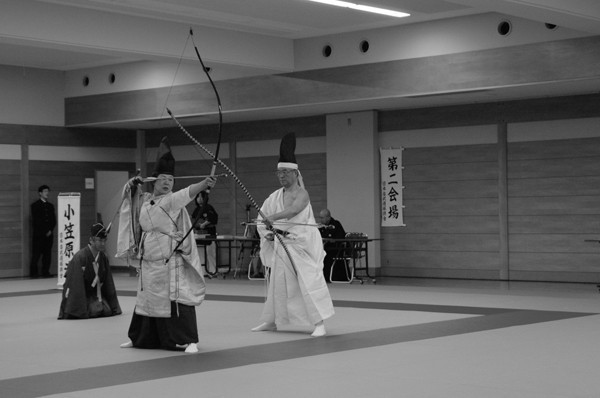
This particular demonstration was important for the Hozoin Ryu too since it was the first public demonstration under the new headmaster of the school. The 62 years old Ichiya Junzo, the present, 21st soke of Hozoin Ryu has been a part of the school since 1976; actually, he first came in contact with the school in 1974 but even though he was from Nara, there was no Hozoin Ryu dojo in Nara in those days. When the 18th headmaster, Ishida Kazuto started the Nara dojo, Ichiya sensei joined immediately and after fifteen years of practice, he got his menkyo kaiden license in 1991. Still, it would be twenty one more years until he became head of the school, after the passing of the previous headmaster and well-known Nara politician Kagita Chubei last December. The five members performing didn’t seem particularly nervous and the demonstration flowed naturally but I am certain there must have been some amount of nervousness –such performances is something that maybe happens only once in a ryuha practitioner’s lifetime, and I believe that even if it didn’t show, the Hozoin Ryu practitioners felt the weight of the occasion on their shoulders!
As an aside, and from what I heard, the Hozoin Ryu is going to enter a new phase under the guidance of Ichiya sensei (who, by the way is also a Zen and sakuhachi practitioner): the new soke wants to increase the popularity of the school hoping it might be able to regain some of its past glory; even though today the Hozoin Ryu boasts about 100 practitioners, these are far fewer from the over 4000 it had back in the Edo period. Since the school is one of the most important classical traditions, I truly wish him good luck in this endeavor.
Back to Hozoin Ryu’s demonstration: it’s always dangerous to try to understand/interpret a school using your own as benchmark but unfortunately it is also unavoidable since it is the only yardstick you have. In the Hozoin’s use of the crosspiece spear I could see similarities to the way we use the crosspiece naginata in Buko Ryu (e.g. the crosspiece being used to pin down the opponent’s weapon, the circular motions used to control the opponent etc.) and there were also many similarities in the way the plain spear is used –especially the fast repeated thrusts to the opponent and the use of space so the spear can keep its advantage.
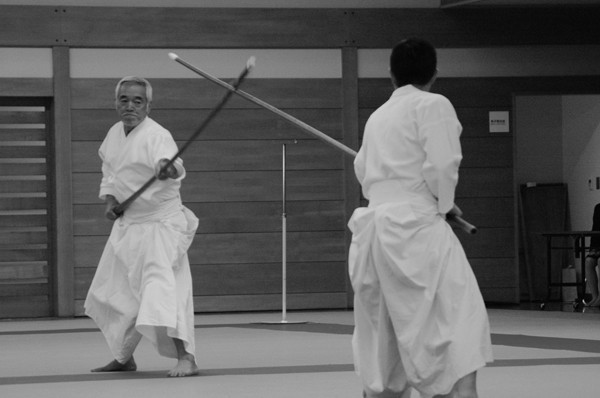
Of particular interest was the use of spear against spear (all the Hozoin Ryu kata use this configuration) something that we don’t have in Buko Ryu, where the spear is put against either the plain naginata or the crosspiece one. I noticed that the Hozoin Ryu spearman sometimes gets a spacing advantage by holding his weapon almost from its edge (i.e. both hands move back to the “base” of the spear); this certainly gives an advantage of at least 50 cm and allows the spearman using a crosspiece spear to use the crosspiece itself as a weapon against the opponent’s hands but I would really like to know how the spearman controls such a long weapon with his hands in that position. From what I saw, the Hozoin spearmen didn’t have any problems with that; I guess there is some special training for how to handle the weapon in such situations.
Overall, the Hozoin Ryu demonstration was a great experience and I hope I have the chance to see the school again, even though such opportunities are not that common; being closely linked to Nara (since the days of its legendary founder, Hozoin Kakuzenbo Inei) they seldom travel to Kanto and I truly believe this is a loss for all of use living in the East. If you have a chance to see them, though, I can certainly recommend it!
Writing something about all 43 schools demonstrating would take the whole magazine so I can only highlight a few things that I had never seen before: first the use of the kusarigama by Araki Ryu and Kiraku ryu; again speaking from a Toda-ha Buko Ryu perspective. Even though Buko Ryu also uses the kusarigama (in fact one of its previous headmasters, Murakami Hideo [1863-1949] was supposed to be extremely proficient in its use) it doesn’t make extensive use of the chain as an offensive weapon. In contrast, both Araki Ryu and Kiraku ryu use it extensively to either disarm the opponent or tangle him with the chain and in some spectacular occasions to tie the chain around his neck and throw him; these techniques, also performed with the chigiriki, are a trademark of both schools and it was interesting to see how different lines perform them.
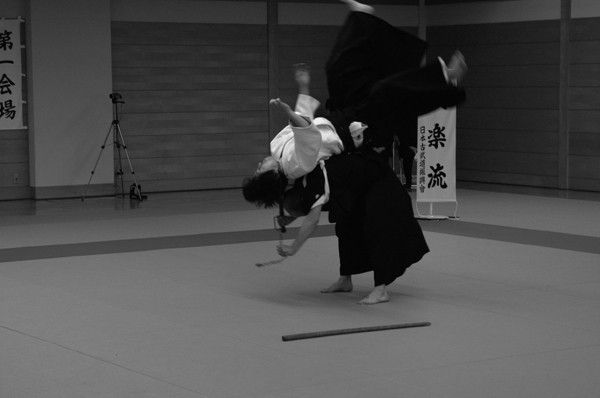
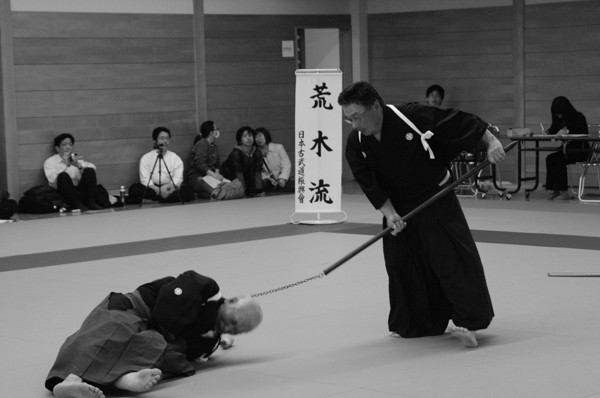
Second it was Kashima Shinden Jikishinkage Ryu kenjutsu. Up until now I was only familiar with the Jikishinkage Ryu naginata and I hadn’t had the opportunity to see the actual Jikishinkage Ryu; needless to say I was impressed if nothing else because of the initial strength/purification exercises done with the enormous “furibo”. Even though the two school exponents were obviously having a hard time controlling this huge weapon, they managed to keep their posture and complete the first part of their demonstration so they could proceed to the second part, the actual kenjutsu using the (also very) big bokuto that are trademark of the school. I have to admit that I had a hard time understanding the logic behind the kata but of course this is not surprising since it was the first time I was seeing the school! What I did notice though, was that the school gives particular emphasis on breathing (kokyu) and kiai (both voiced and silent); this was pretty much apparent in the way the two practitioners were focusing on each other.
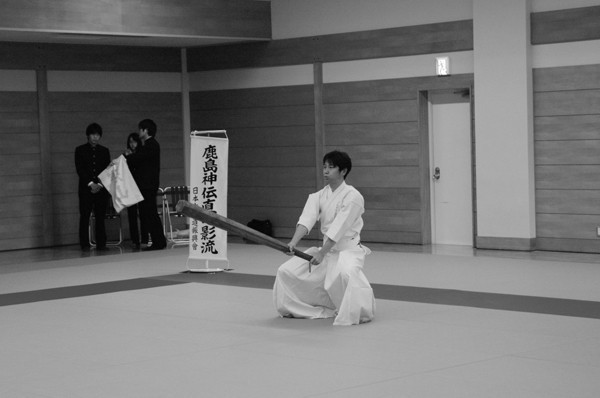
Third (and again seeing things from a Buko Ryu perspective) it was very interesting to see one more time how Tenshin Shoden Katori Shinto Ryu puts the naginata against a sword. In Buko Ryu, the naginata is almost always held closer to its butt end so practitioners can utilize its full length and get the advantage against the (very shorter) sword. Katori Shinto Ryu though, I guess because it is mainly a sword school, uses the naginata from a much shorter distance with the exponent holding it in the middle as someone would hold a bo. This of course gives the naginata an added versatility and speed in movement which is very well suited to the very fast pace of the highly sophisticated Katori Shinto Ryu kata.
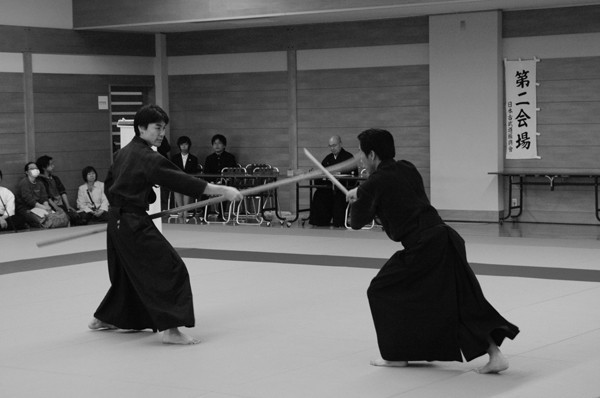
Speaking of putting a long weapon against a short one, in the Asakusa Taikai I saw for the first time Tatsumi Ryu’s interpretation of a fight between a spear and a sword; I knew that the school has an extensive curriculum of various weapons and tactics but I hadn’t seen before their use of the spear. As expected, the swordsman moves very fast so he can get inside the spear’s range, where his weapon is more effective, something that most non-martial artists wouldn’t understand since the initial instinct would be to get as far from the long weapon as possible. The Tatsumi Ryu swordsman knows that this wouldn’t make any sense from a strategic viewpoint (since that way the spear keeps its advantage) so he does the only reasonable thing: closes the distance and regains the advantage.
As I mentioned before, besides Buko Ryu I have also trained in iaido for eight years; this means that even though now my main weapon is the naginata, I still have a big interest for the magnificent weapon that is the Japanese sword. From this viewpoint, I particularly enjoyed the Shin Muso Hayashizaki Ryu and how they manage to handle their big (over 1 m) sword even in very close engagements (i.e. against a short sword), how the Muso Shinden Ryu and the Negishi Ryu uses the sword combined with a fan and with shuriken respectively and how the Shingyoto Ryu handles the paired swords (the part where the swordsman hides the short sword behind his back was especially interesting). Also, it was exciting to see for the first time the fast kenjutsu of the Shindo Munen Ryu a school of which until now I had only seen the iai component (in Europe most people know Shindo Munen Ryu as an iai ryu) and, for one more time the legendary energetic kenjutsu of the Yagyu Shinkage Ryu. Last, but no least (and this time speaking as a former aikidoka and judoka) I was fascinated by the kumi uchi/koshi no mawari part of the Sosuishi Ryu, which reminded me of sumo and gave me an idea of how people must have fought while wearing armor.
Like always, the last demonstration was from Morishige Ryu Hojutsu. I had seen the Morishige Ryu demonstrate before and since that time the demonstration was outdoors (in the Meiji Jingu) I had the opportunity to see the members of the school perform both in clothes and in armor and, most important to hear how the weapons sound when fired; I have fired weapons both in the army and in shooting galleries and I have to admit that the sound of Morishige Ryu’s matchlock muskets (hinawaju) and of their small cannon (which always comes last) were surprisingly loud! This time, though, since the demonstration was indoors, the guns weren’t actually fired but this didn’t stop the five members of the school demonstrate their kata perfectly substituting the sound of the gun with an actual sound they made with their mouths. I saw that some members of the audience (and especially foreigners) found this mimicry a little funny but for me it made perfect sense and it reminded me of the close target shooting done in kyudo when space considerations don’t allow the archers to perform normally. What was most important was that the members of Morishige Ryu completed their demonstration as if the guns were lit and fully loaded; such emphasis on the correct form with adaption to the surrounding environment is the mark of a really alive tradition.
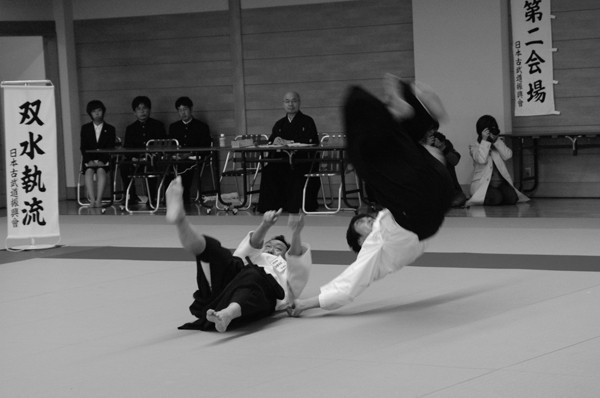
We left the Taito Riverside Sports Center shortly after all demonstrating participants had gone. Passing from the Azumabashi for a last stroll before returning home, I noticed a young geisha, without her wig and her make-up but bearing the rest of the unmistakable sartorial marks of her profession waiting in the traffic light and once again I thought how amazing it is that even in its most modern core, with the Asahi building and the Sky Tree dominating the scene this city and this country manage to keep alive the old ways. Even though the samurai don’t roam swaggeringly the streets as they used to, they still exist and their endurance against the currents of time clearly shows the strength and the adaptability of these traditions and of the men and women who have been carrying them through the ages.
Related article:30th Asakusa Kobudo Taikai, April 2012: Under the shadow of the Sky Tree Part.1
 About the author
About the author
Grigoris Miliaresis has been practicing Japanese martial arts since 1986. He has dan grades in judo, aikido and iaido and has translated in Greek over 30 martial arts’ books including Jigoro Kano’s “Kodokan Judo”, Yagyu Munenori’s “The Life-Giving Sword”, Miyamoto Musashi’s “Book of Five Rings”, Takuan Shoho’s “The Unfettered Mind” and Donn Draeger’s “Martial Arts and Ways of Japan” trilogy. Since 2007 his practice has been exclusively in classic schools: Tenshin Buko-ryu Heiho under Ellis Amdur in Greece and Kent Sorensen in Japan and, since 2016, Ono-ha Itto-ryu under 17th headmaster Sasamori Takemi and 18th headmaster Yabuki Yuji.
http://about.me/grigorismiliaresis

















